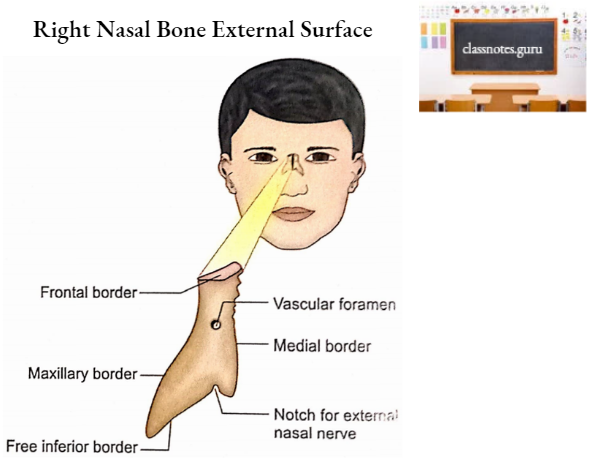Nasal Bones
Nasal Bones Terminology
The nasal bone is so named because of its location. It forms the bridge of the nose.
Nasal Bones Location
Two nasal bones meet with each other in the midline in the upper part of the external nose. They are located below the nasal part of the frontal bone and between the frontal processes of the maxillae.
Nasal Bones Features And Attachments
Each nasal bone has two surfaces (external and internal) and four borders (superior, inferior, lateral, and medial).
Nasal Bones Surfaces
1. External Surface
- It is convex from side to side.
- It is covered by the procerus and nasalis muscles.
- A foramen in the center (vascular foramen) allows the transmission of a small vein.

2. Internal Surface
- It is concave from side to side
- It presents a vertical groove for the anterior ethmoidal nerve.

Nasal Bones Borders
1. Superior Border
- It is serrated.
- It articulates with the nasal part of the frontal bone.
2. Inferior Border
- It is notched for the passage of the external nasal nerve.
- It is continuous with the lateral nasal cartilage.
3. Lateral Border
It articulates with the frontal process of the maxilla.
4. Medial Border
- It is thicker above than below.
- It articulates with the opposite nasal bone (to form an internasal suture) and is prolonged behind as a nasal crest.
- The nasal crest articulates with the following structures from above downwards:
- The nasal spine of the frontal bone.
- Perpendicular plate of ethmoid.
- Septal cartilage.
Nasal Bones Ossification
Nasal bone ossifies in the membrane overlying the anterior part of the cartilaginous nasal capsule
The Centre of ossification appears in its middle during 3rd month of intrauterine life.
Nasal Bones Applied Anatomy
- Nasal bone is usually fractured due to a direct hard blow.
- The fractures of the nasal bone are transverse in nature.
- The common site for the fracture of the nasal bone is half (2) inches above its inferior border.
- The slight mobility of the anteroinferior part of the nasal bone protects the nose against mild injuries.
- An impact directed in the anteroposterior plane will cause a depression of the nasal bridge due to a fracture of the nasal bone, frontal process of the maxilla, and septal cartilage.
- A force directed from the lateral aspect will result in a deviation of the nasal bridge to the opposite side.
- Traumatic alteration in the shape of the nose because of fracture of nasal bones is of great clinical importance due to cosmetic reasons, especially in young females.
- In cases of Le Fort 2 and Le Fort 3 fractures of maxillae, nasal bones are also involved. Le Fort 1 fracture of maxillae spares the nasal bone.

